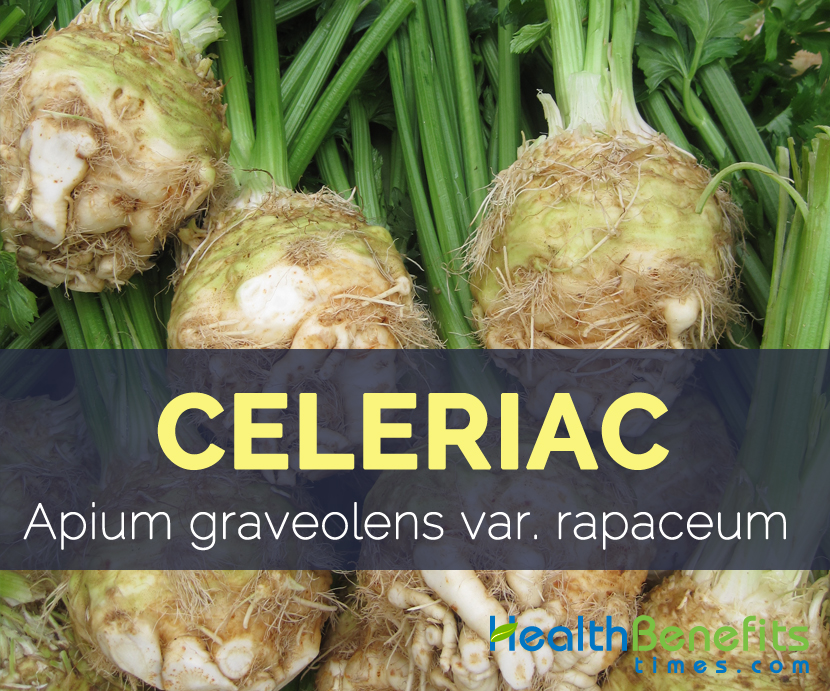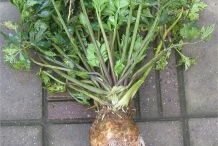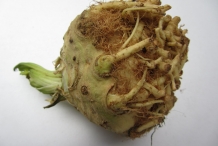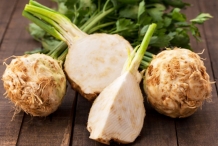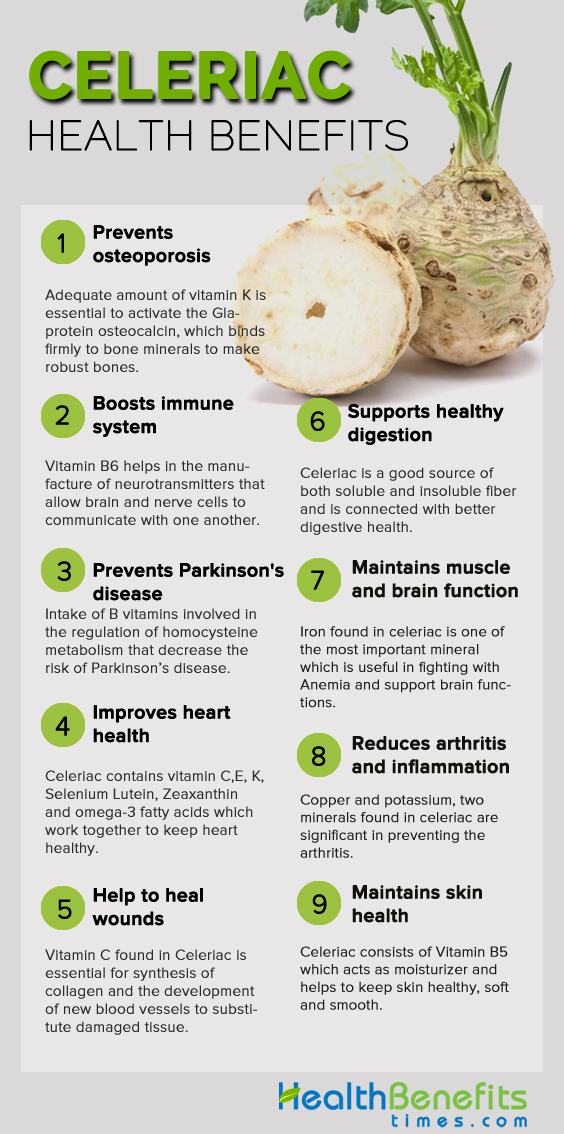| Celeriac Quick Facts | ||
|---|---|---|
| Name: | Celeriac | |
| Scientific Name: | Apium graveolens var. rapaceum | |
| Origin | Italy | |
| Colors | Light brown | |
| Shapes | Large,swollen, knobby, rounded to odd shape, 7–12 cm across | |
| Flesh colors | Creamy white | |
| Taste | Bit like celery and parsley | |
| Calories | 66 Kcal./cup | |
| Major nutrients | Vitamin K (53.33%) Phosphorus (25.57%) Vitamin B6 (19.77%) Vitamin C (13.89%) Iron (13.63%) |
|
| Health benefits | Supports healthy digestion, Help to heal wounds, Improves heart health, Helps prevent Parkinson's disease, Helps defend against cognitive decline and boost immune system, Helps bone density and prevent osteoporosis, Helps maintain muscle and brain function, Reduces inflammation and arthritis, Maintains skin health | |
| Proximity | Amount | % DV |
|---|---|---|
| Water | 137.28 g | N/D |
| Energy | 66 Kcal | N/D |
| Energy | 275 kJ | N/D |
| Protein | 2.34 g | 4.68% |
| Total Fat (lipid) | 0.47 g | 1.34% |
| Ash | 1.56 g | N/D |
| Carbohydrate | 14.35 g | 11.04% |
| Total dietary fiber | 2.8 g | 7.37% |
| Soluble dietary fiber | 1.47 g | N/D |
| Insoluble dietary fiber | 1.33 g | N/D |
| Total Sugar | 2.5 g | N/D |
| Minerals | Amount | % DV |
|---|---|---|
| Calcium, Ca | 67 mg | 6.70% |
| Iron, Fe | 1.09 mg | 13.63% |
| Magnesium, Mg | 31 mg | 7.38% |
| Phosphorus, P | 179 mg | 25.57% |
| Potassium, K | 468 mg | 9.96% |
| Sodium, Na | 156 mg | 10.40% |
| Zinc, Zn | 0.51 mg | 4.64% |
| Copper, Cu | 0.109 mg | 12.11% |
| Manganese, Mn | 0.246 mg | 10.70% |
| Selenium, Se | 1.1 µg | 2.00% |
| Vitamins | Amount | % DV |
|---|---|---|
| Water soluble Vitamins | ||
| Vitamin B1 (Thiamin) | 0.078 mg | 6.50% |
| Vitamin B2 (Riboflavin) | 0.094 mg | 7.23% |
| Vitamin B3 (Niacin) | 1.092 mg | 6.83% |
| Vitamin B5 (Pantothenic acid) | 0.549 mg | 10.98% |
| Vitamin B6 (Pyridoxine) | 0.257 mg | 19.77% |
| Vitamin B9 (Folate) | 12 µg | 3.00% |
| Folic Acid | 0 µg | N/D |
| Folate, food | 12 µg | N/D |
| Folate, DEF | 12 µg | N/D |
| Choline | 14 mg | 2.55% |
| Vitamin C (Ascorbic acid) | 12.5 mg | 13.89% |
| Fat soluble Vitamins | ||
| Lutein + zeaxanthin | 2 µg | N/D |
| Vitamin E (alpha-tocopherol) | 0.56 mg | 3.73% |
| Vitamin K (phylloquinone) | 64 µg | 53.33% |
| Lipids | Amount | % DV |
|---|---|---|
| Fatty acids, total saturated | 0.123 g | |
| Myristic acid 14:00(Tetradecanoic acid) | 0.003 g | N/D |
| pentadecanoic acid (15:00) | g | N/D |
| Palmitic acid 16:00 (Hexadecanoic acid) | 0.108 g | N/D |
| Stearic acid 18:00 (Octadecanoic acid) | 0.009 g | N/D |
| Fatty acids, total monounsaturated | 0.09 g | |
| Palmitoleic acid 16:1 (hexadecenoic acid) | 0.003 g | N/D |
| Oleic acid 18:1 (octadecenoic acid) | 0.087 g | N/D |
| Fatty acids, total polyunsaturated | 0.231 g | |
| Linoleic acid 18:2 (octadecadienoic acid) | 0.231 g | N/D |
| Flavones & Flavonols | Amount | % DV |
|---|---|---|
| Flavones | ||
| Apigenin | 3.8 mg | N/D |
| Flavonols | ||
| Quercetin | 0.3 mg | N/D |
Health benefits of Celeriac
Celeriac is an herbaceous biennial vegetable which can be found growing in cool and moist place. It is a popular root vegetable for its big and bulbous hypocotyl which has taste similar to celery and parsley, normally one single hypocotyl weights 1-2 pound. Due to its distinctive taste it is found used in several dishes, soups, and stews as well as consumed raw.
- Helps bone density and prevent osteoporosis
Celeriac is one of the best suppliers of essential Vitamin K, with over 53% of your daily value in every half cup (64 µg). Adequate amount of vitamin K is essential to activate the Gal-protein osteocalcin, which binds firmly to bone minerals to make robust bones. With insufficient vitamin K, bones cannot hold on to vital calcium that results to osteoporosis. To make matters worse, the calcium has to go somewhere, so it enters the bloodstream, where it contributes to stiffening arteries. Luckily, celeriac provides a high dose of essential Vitamin K that can be an effective means of protecting your bones from osteoporosis. (1)
Besides Vitamin K celeriac also consists of bone friendly minerals like calcium and phosphorus which are essential for maintaining bone strength and structure. In fact, more than half of all bone is made from phosphate. Manganese helps with the formation of bone regulatory hormones and enzymes involved in bone metabolism, phosphors helps form bone mineral density which avoids bone fractures, breaks and osteoporosis – which all are more probable as someone ages. Without sufficient phosphorus, calcium alone cannot effectively build and maintain the bone health. More calcium alone cannot increase bone density, since both minerals are required to form bone mass.156 grams of Celeriac consists of 25% phosphorus, 10% Manganese and 6% Calcium of the recommended dietary allowance which are balanced to maintain strong bones. According to research, taking manganese along with other bone-supporting nutrients like calcium, zinc, magnesium and copper can improve bone mass in women along with weak bones, which is beneficial to naturally treat osteoporosis. (2), (3)
- Helps defend against cognitive decline and boost immune system
Vitamin B6 also known as Pyridoxine is a powerful vitamin, and there is a lot of it available in Celeriac. One serving offers 20% of your daily supply of Vitamin B6, which helps in the manufacture of neurotransmitters, the chemicals that allow brain and nerve cells to communicate with one another, confirming that metabolic processes such as fat and protein metabolism run effortlessly, and is significant for immune system function in older persons. It can also help deal with conditions, like nerve compression injuries (like carpal tunnel syndrome), some cases of depression and arthritis and premenstrual syndrome (PMS).
- Helps prevent Parkinson’s disease
Increased homocysteine levels might accelerate dopaminergic cell death in Parkinson’s disease through neurotoxic effects; therefore, increasing intake of B vitamins involved within the managements of homocysteine metabolism may decrease the risk of PD through declining plasma homocysteine. Research concluded that sufficient intake of vitamin B6 was related with reduced chance of Parkinson’s disease. (4) Celeriac contain 14% of daily require value of Vitamin B6.
- Improves heart health
Celeriac consists of vitamin K, numerous antioxidants like vitamin C, vitamin E, Selenium Lutein and Zeaxanthin, and small quantities of omega-3 fatty acids. All these vitamins, antioxidants and omega-3s work together to keep arteries clear of hazardous plague buildup, to lower cholesterol levels, to combat high blood pressure, to increase blood flow and to sustain healthy, strong blood vessels. Such important benefits decrease the chance of heart attack as well as other cardiovascular problems that affect millions of people every year.
- Help to heal wounds
Vitamin C found in Celeriac is essential for synthesis of collagen and the development of new blood vessels to substitute damaged tissue. This element also has a strong autoxidizing effect that boosts the immune system and protects against wound infection. Inflammatory responses frequently increase free radicals at the site of injury and the presence of vitamin C might limit free radical damage, free radicals may create difficulty in the wound healing process. Another perk is that vitamin C helps the body better absorb iron, which works to supply the wound bed with oxygen and energy for more efficient cellular development. (5)
- Supports healthy digestion
Fiber is an essential part of the diet and is connected with better digestive health. Celeriac is a good source of both soluble and insoluble fiber. Soluble fiber forms a gel-like substance in the gut. It is a respected source of nutrients for the beneficial digestive bacteria, and may also decrease spikes in blood sugar and control cholesterol levels. Insoluble fiber adds bulk to fecal matter and may help food and waste pass through the gut. Consuming insoluble fiber has also been related with a decreased risk of diabetes. Most of the dietary fiber is present in fruit peel of Apple. Though must eat apple with skin go get benefits from dietary fiber. (6)
- Helps maintain muscle and brain function
Iron found adequately in Celeriac is one of the most important mineral which is extremely useful in fighting with Anemia simply by helping to adequate manufacture of Red blood cells and hemoglobin, therefore high oxygen supply throughout the body cells. Similarly iron also helps with metabolic enzyme processes that body carries to digest protein as well as absorbs nutrients from foods. Iron deficiency normally results in mood changes, low concentration and trouble with muscle coordination. Iron is required for muscle movements because it helps to store oxygen in muscles which helps them to move as well as strengthen. (7)
Apart from that Iron is equally important for supporting brain functions because it transports oxygen towards the brain, in fact about 20% of the oxygen in body is used by brain. Due to this fact, an iron deficiency may results in weaken memory as well as other mental functions, Iron deficiency may result in psychomotor and cognitive abnormalities in infants and young children which have the possibility to result in learning difficulties. (8)
- Reduces inflammation and arthritis
Celeriac is a high source of Copper and potassium, two minerals which are significant in preventing the arthritis. Copper has anti-inflammatory capabilities which help to relieve pain and rigorousness related with arthritis. It also has the capability to help with muscular strength, to reduce joint pain, and to repair connective tissue. Potassium is an important mineral and electrolyte responsible for the function of all cells, tissues and organs in your body. It is crucial in both skeletal and smooth muscle contractions. Potassium can be acquired through a healthy diet and is found in vegetables like celeriac. Potassium also plays important role to balance proper amount of sodium and magnesium in the body. (9)
Arthritis sufferers even choose to wear copper bracelets or bands because it is supposed that copper is absorbed by skin and can help minimize painful symptoms. (10) Apart from that certain topical applications made up of potassium have shown some promise as anti-inflammatory agents. One current research mixed potassium with a topical rub and is applied to the joint, with the patient reporting reduced pain.
- Maintains skin health
Celeriac consists of important pro Vitamin B5 which is also called Pantothenic acid which acts as moisturizer and helps to keep skin healthy, soft and smooth. It also acts as anti-inflammatories simply by encouraging your skin’s healing processes. It is very hydrating and helps to keep skin moist simply by absorbing moisture from air. Celeriac consists of reasonable amount of Vitamin B5 (nearly 0.549 mg per cup). It is a water soluble vitamin that cannot be stored in the body therefore celeriac root must be included in your regular diet. (11), (12)
How to Eat
- Celeriac is a multipurpose vegetable and are used both cooked and raw in salads.
- It is also used as a flavoring in casseroles, stews and soups, but can also be mashed or baked.
- Mashed celeriac is best when mixed with other root vegetable like potatoes to create a smoother purée consistency.
- Classic dish celeriac remoulade, where the vegetable is grated or cut into small pieces and served with a mustard mayonnaise.
- It is used raw in salads, grated and frequently tossed with creamy salad dressings.
- Celeriac combines well with meats such as pork, lamb and duck and herbs like bay leaves and thyme.
- The leaves can also be used as flavoring in soups or eaten raw but have a very powerful flavor.
- The leaves can be dried for flavoring salt.
- Seed or its essential oil is also used as flavoring agents.
Other Facts
- It has been stated to have insect repellent property; it repels the cabbage white butterfly thus it is a good companion for tomatoes, Allium and Brassica vegetables.
Precautions
- Celeriac contains several furano-coumarin compounds like bergapten, psoralen, xanthotoxin and isopimpinellin which may cause skin to burn (photo-toxicity) in some sensitive individuals.
- Moreover, like celery, it must be avoided in large quantities in pregnant women.
- People on diuretic medications and anti-coagulant medications should use this root cautiously.
Celeriac – Apium graveolens var. rapaceum Facts
Celeriac is a well-known root vegetable which is native to Italy and is extremely popular nowadays due to its important vitamins, minerals and essential nutrients. It is cultivated worldwide due to its benefits.
| Name | Celeriac |
| Scientific Name | Apium graveolens var. rapaceum |
| Native | Italy |
| Common/English Name | Celeriac, Turnip-Rooted Celery, Turnip-Root Celery, Celery Root, Knob Celery |
| Name in Other Languages | Bulgarian : Tselina Vietnamese : Củ German : Eppich Spanish : Apio Nabo French : Ache-Douce Croatian : Celer Japanese : Ne-yō serori Portuguese : Aipo-rábano Dutch : Knolselderij Finnish : Mukula Eli Juuriselleri Afrikaans : Selder Slovašcina : Gomoljna zelena Latvian : Selerijas Romanian : Telină Chinese : Gen Qin Cai Macedonian : Korenaš Serbian : Celer Greek : Selinóriza Hungarian : Zeller Danish : Knoldselleri Swedish : Rotselleri Italian : Sedano Rapa Slovencina : Zeler voňavý buľvový Polish : Seler Korzeniowy Korean : Selleoli Estonian : Juurseller Turkish : Kerevic Norwegian : Knollselleri Czech : Celer bulvový German : Eppich Russian : Kornevoi Sel’derei Welsh : Seleriac |
| Plant Growth Habit | Deciduous, herbaceous, erect, biennial |
| Growing Climate | Temperate climatic regime, cool and moist. |
| Soil | Moist, rich, friable soil |
| Plant Size | 1 m high by 0.5 m wide |
| Root Shape and Size | Large, swollen, knobby, rounded to odd shape, 7–12 cm across |
| Root Color | Brown, rough skin, thick and mottled. |
| Root weight | 1-2 pound. |
| Flesh Color | Creamy white and firm |
| Root Flavor | Sweet, earthy, nutty, delicate celery flavor. |
| Root Taste | Bit like celery and parsley |
| Leaf | Pinnate leaves with rhombic leaflets and hollow stalks |
| Flower | Flowers are creamy white, 2–3 mm diameter, produced in dense compound umbels. |
| Seed | Broad ovoid to globose, 1.5–2 mm long and wide. |
| Season | March and September |
| Major Nutrition | Vitamin K (phylloquinone) 64 µg (53.33%) Phosphorus, P 179 mg (25.57%) Vitamin B6 (Pyridoxine) 0.257 mg (19.77%) Vitamin C (Ascorbic acid) 12.5 mg (13.89%) Iron, Fe 1.09 mg (13.63%) Copper, Cu 0.109 mg (12.11%) Carbohydrate 14.35 g (11.04%) Vitamin B5 (Pantothenic acid) 0.549 mg (10.98%) Manganese, Mn 0.246 mg (10.70%) Sodium, Na 156 mg (10.40%) |
| Health Benefits |
|
| Calories in 1cup (156gm) | 66 Kcal |
References:
https://en.wikipedia.org/wiki/Celeriac
https://www.betterhealth.vic.gov.au/health/ingredientsprofiles/Celeriac
http://aggie-horticulture.tamu.edu/plantanswers/vegetables/celeriac.html
http://www.cs.mcgill.ca/~rwest/wikispeedia/wpcd/wp/c/Celeriac.htm


